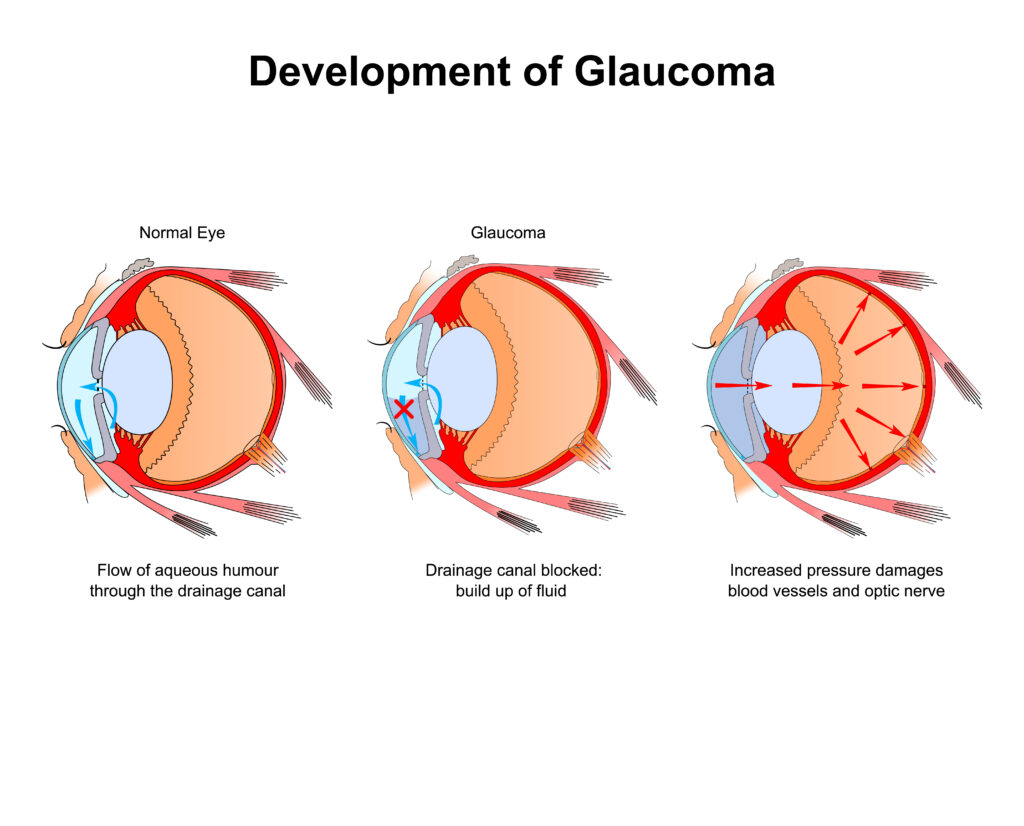Glaucoma is a serious eye disease that can steal your sight without warning. In its most common form, open-angle glaucoma, vision loss occurs gradually.
Many patients don’t realize they have this eye condition until they suffer irreversible and permanent vision loss. Glaucoma having few, if any, symptoms makes eye exams critical for catching the condition early.
Keep reading to learn what to know about glaucoma having no symptoms and what this can mean for your vision if left unchecked!
What is Glaucoma?

Glaucoma is an eye condition that slowly damages the optic nerve. The optic nerve is a bundle of nerve fibers that sends signals from the eye to the brain, allowing you to see.
Damage to the optic nerve is usually caused by high pressure inside the eye. This pressure, called intraocular pressure, builds up when the clear fluid in the front of the eye can’t drain properly.
There are different types of glaucoma, but the most common is open-angle glaucoma. In open-angle glaucoma, the drainage channels in the eye look normal, but the fluid can’t flow out properly. It develops slowly and is irreversible.
Angle-closure glaucoma occurs when the drainage angle becomes blocked, leading to a sudden increase in pressure. It is a medical emergency requiring immediate treatment to prevent permanent vision loss.
Why Does Glaucoma Have No Symptoms?
One thing that makes open-angle glaucoma tricky is there are usually no warning signs or symptoms, especially during its early stages. Pressure from open-angle glaucoma typically builds up very slowly over time.
Your eyes can adjust to this gradual change in pressure, so you may not experience any pain or discomfort because of it. Any damage being done to the optic nerve also happens slowly over time.
Your brain is excellent at adapting to small changes in vision, so you might not notice that your sight is getting worse at first. Glaucoma usually affects your peripheral vision, which is your side vision, before it affects central vision.
Having glaucoma won’t affect many daily tasks like reading, at least in the early stages. Glaucoma has few, if any, symptoms during its early stages, which is why the condition is sometimes referred to as the silent thief of sight.
It can sneak up on you and steal your vision slowly over time without you realizing it. Most patients with glaucoma don’t know they have the eye condition until permanent and irreversible vision loss has already occurred.
How Do You Know If You Have Glaucoma?
Because glaucoma may not initially have symptoms, the best way to catch and diagnose the eye condition is with frequent eye exams with your ophthalmologist. During a comprehensive dilated eye exam, your eye doctor will dilate your pupils with eye drops.
Dilating your pupils allows them to examine your optic nerve and detect any signs of damage. They will also measure your eye pressure and inspect the drainage angle.
Certain people may be at an increased risk of developing glaucoma. Your risk of developing glaucoma increases if:

- You’re over 60
- You have a family history of the eye condition
- You’re African American or Hispanic
- You have diabetes
- You have high blood pressure
If you fall into one of these criteria, your ophthalmologist may want you to schedule eye exams more frequently. You need to check your eyes and have eye exams regularly, even if you don’t have symptoms.
If glaucoma is diagnosed early, you can start treatment immediately and preserve your vision.
Treating Glaucoma
If you’re diagnosed with glaucoma, the next step is treatment. Although any damage from the eye condition is irreversible, treatment can typically slow or stop further damage to the optic nerve.
Treating glaucoma aims to lower your intraocular pressure. Most ophthalmologists will start with eye drops to treat glaucoma.
Using eye drops to treat glaucoma helps reduce the amount of fluid your eye creates or helps the fluid in your eye drain more effectively. If eye drops aren’t enough, your ophthalmologist may have you try pills. If these methods don’t help, you may need laser treatment or surgery to improve fluid drainage from your eye and reduce intraocular pressure.
Sticking to your treatment plan is essential, even if you can’t see if it’s working. You may not feel any different, but treatments like eye drops and medications protect your vision from glaucoma progression.
Choosing not to treat glaucoma could lead to the eye condition progressing and losing more of your eyesight. Your ophthalmologist will monitor your intraocular pressure and optic nerve to ensure treatment works.
What Does Glaucoma Do to Your Vision?

In the early stages, open-angle glaucoma first affects your peripheral vision. You may not notice losing your peripheral vision initially, as it happens slowly over time, and your brain can adapt to this change.
Over time, as the optic nerve gets more damaged, your side vision will narrow. Many patients feel this is like looking through a tunnel, which is why it’s often called tunnel vision.
If glaucoma is not treated, damage continues progressing until only a tiny amount of your central vision is left. The result is like looking through a pinhole. Eventually, glaucoma can leave you completely blind.
Fortunately, if glaucoma is detected and treated early, you should be able to preserve most of your remaining vision. This makes scheduling eye exams regularly with your eye doctor crucial, especially if you’re considered at higher risk for the eye condition.
If you can’t remember the last time you had an eye exam, that may be a sign it’s been too long. Glaucoma is a sneaky eye condition that can cause permanent vision loss and almost no warning signs or symptoms.
Do you need to treat glaucoma? Learn more about this eye condition by requesting an appointment at South Texas Eye Institute in San Antonio, TX, now!

